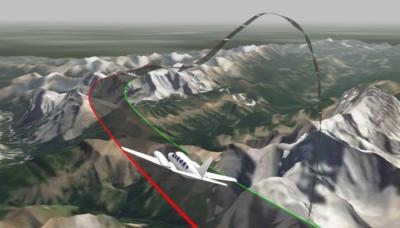Sat, Aug 03, 2019
Piper PA-31 Collided With Terrain In Kananaskis Country, Alberta
In the release of its investigation report (A18W0116), the Transportation Safety Board of Canada (TSB) found that hypoxia ... in-flight oxygen deprivation ... likely played a role in the loss of control that resulted in a fatal 2018 aircraft accident over Mount Rae, Alberta.

In the afternoon of 1 August 2018, after completing two hours of survey activities, an Aries Aviation International Piper PA-31 aircraft was proceeding to Calgary/Springbank Airport Alberta (CYBW), at 15,000 feet above sea level (ASL), with a pilot and a survey technician on board. Approximately 40 nautical miles southwest of the airport, air traffic control began sequencing the aircraft for arrival into the Calgary airspace. At this time, for reasons that could not be determined, the right engine began operating at a significantly lower power setting than the left engine. About 90 seconds later, at approximately 13,500 feet, the aircraft departed controlled flight. The aircraft collided with terrain near the summit of Mount Rae at 13:36 (MDT). The pilot and survey technician were both fatally injured.
The investigation determined that, although a portable oxygen system was activated and available, the pilot was not continuously using oxygen while the aircraft was above 13,000 feet ASL, as required by regulation, and likely became hypoxic. Although hypoxia can cause pronounced performance degradations, its onset can be slow and gradual, making it likely the pilot did not recognize the symptoms, and thus took no action to restore his supply of oxygen. The investigation also found that if flight crews do not undergo practical hypoxia training, there is a risk they will not recognize its onset when flying above 13 000 feet without continuous use of supplemental oxygen.
The aircraft was not equipped with a flight data recorder or cockpit voice recorder, nor were these required by regulation. However, the aircraft was equipped with a flight data monitoring system that included a camera. This system provided significant information to help TSB investigators better understand the underlying factors that contributed to the accident.
(Source: TSB news release. Image from TSB Report)
More News
Aviation Governance Secured...At Least For a While The National Business Aviation Association similarly applauded the passage of the FAA's recent reauthorization, contentedly recou>[...]
Emphasis On Growing The Future of Aviation Through Concentration on 'AFFORDABLE FLYERS' It's been a number of years since the Latest Edition of Jim Campbell's HUGE SportPlane Resou>[...]
Amazilia Aerospace GmbH, Develops Digital Flight Control, Flight Guidance And Vehicle Management Systems Textron eAviation has acquired substantially all the assets of Amazilia Aer>[...]
Honeywell's Primus Brings New Tools and Niceties for Hawker Operators Hawker 4000 business jet operators have a new installation on the table, now that the FAA has granted an STC f>[...]
Company Celebrates Niche-but-Important Advancement in Industry Standards Echodyne has announced full integration of its proprietary 'EchoFlight' radar into the e American Aerospace>[...]
 Bolen Gives Congress a Rare Thumbs-Up
Bolen Gives Congress a Rare Thumbs-Up The SportPlane Resource Guide RETURNS!!!!
The SportPlane Resource Guide RETURNS!!!! Buying Sprees Continue: Textron eAviation Takes On Amazilia Aerospace
Buying Sprees Continue: Textron eAviation Takes On Amazilia Aerospace Hawker 4000 Bizjets Gain Nav System, Data Link STC
Hawker 4000 Bizjets Gain Nav System, Data Link STC Echodyne Gets BVLOS Waiver for AiRanger Aircraft
Echodyne Gets BVLOS Waiver for AiRanger Aircraft



